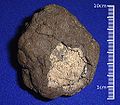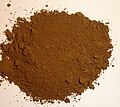| Umber | |
|---|---|
| Hex triplet | #635147 |
| sRGBB (r, g, b) | (99, 81, 71) |
| HSV (h, s, v) | (21°, 28%, 39%) |
| CIELChuv (L, C, h) | (36, 15, 39°) |
| Source | ISCC NBS |
| B: Normalized to [0–255] (byte) | |
Umber is a natural brown or reddish-brown earth pigment that contains iron oxide and manganese oxide. It is darker than the other similar earth pigments, ochre and sienna. [1]
In its natural form, it is called raw umber. When heated (calcinated), the color becomes more intense, and the color is known as burnt umber.
The name comes from terra di ombra, or earth of Umbria, the Italian name of the pigment. Umbria is a mountainous region in central Italy where the pigment was originally extracted. [2] The word also may be related to the Latin word Umbra and the old French word ombre, meaning shade or shadow [3]
Umber is not one precise color, but a range of different colors, from medium to dark, from yellowish to reddish to grayish. The color of the natural earth depends upon the amount of iron oxide and manganese in the clay. Commercial colors vary depending upon the manufacturer or the color list. Not all umber pigments contain natural earths; some contain synthetic iron and manganese oxide, indicated on the label. Pigments containing the natural umber earths indicate them on the label as PBr7 (Pigment brown 7), following the Colour Index International system.
The color shown in the box at right is one of the many commercial varieties of umber, from the ISCC-NBS color list: ISCC-NBS Dictionary of Color Names (1955)--Color Sample of Umber (color sample #61).
-
Limonite, or hydrated iron oxide, is the basic ingredient of the earth pigments ocher, sianna and umber.
-
The presence of a large amount of manganese makes umber earth colors darker than ocher or sienna.
-
The pigment known as raw umber of natural umber came originally from Umbria, in Italy.
-
Another sample of natural umber pigment, from the Italian Wikipedia.
Raw umber
| Raw Umber | |
|---|---|
| Hex triplet | #826644 |
| sRGBB (r, g, b) | (130, 102, 68) |
| HSV (h, s, v) | (33°, 48%, 51%) |
| CIELChuv (L, C, h) | (45, 33, 52°) |
| Source | ISCC NBS |
| B: Normalized to [0–255] (byte) | |
| Terra d'ombra | |
|---|---|
| Hex triplet | #8A3324 |
| sRGBB (r, g, b) | (138, 51, 36) |
| HSV (h, s, v) | (9°, 74%, 54%) |
| CIELChuv (L, C, h) | (34, 69, 17°) |
| Source | Italian wikipedia |
| B: Normalized to [0–255] (byte) | |
Displayed at the right is one version of the color raw umber.
The second box, Terra d'ombra, is the Italian version of natural umber, from the Italian Wikipedia.
These approximate the color of the raw natural clay earth pigment.
The source of this color is: ISCC-NBS Dictionary of Color Names (1955)--Color Sample of Raw Umber (color sample #77).
Burnt umber
| Burnt umber | |
|---|---|
| Hex triplet | #8A3324 |
| sRGBB (r, g, b) | (138, 51, 36) |
| HSV (h, s, v) | (9°, 74%, 54%) |
| CIELChuv (L, C, h) | (34, 69, 17°) |
| Source | Xona.com Color List |
| B: Normalized to [0–255] (byte) | |
Burnt umber is both a pigment and a color. This medium brown pigment is made by heating umber, a dark brown clay containing oxides of iron and manganese. It is used for oil and water color paint.
The first recorded use of burnt umber as a color name in English was in 1650.[4]
| Terra d'ombra bruciata | |
|---|---|
| Hex triplet | #712F26 |
| sRGBB (r, g, b) | (113, 47, 38) |
| HSV (h, s, v) | (7°, 66%, 44%) |
| CIELChuv (L, C, h) | (29, 49, 17°) |
| Source | Italian wikipedia |
| B: Normalized to [0–255] (byte) | |
See also
References
- ^ Shorter Oxford English Dictionary, Fifth Edition, Oxford University Press, 2002. "A red brown earth containing iron and manganese oxides and darker than ochre and sienna, used to make various pigments."
- ^ Shorter Oxford English Dictionary, Fifth Edition, Oxford University Press, 2002.
- ^ Blick Art Materials, 00501-8054 — Burnt Umber
- ^ Maerz and Paul A Dictionary of Color New York:1930 McGraw-Hill Page 191; Color Sample of Burnt Umber: Page 53 Plate 15 Color Sample A12
External links
| Borates | |||||
|---|---|---|---|---|---|
| Carbonates | |||||
| Oxides |
| ||||
| Phosphates | |||||
| Silicates | |||||
| Sulfides | |||||
| Other |
| ||||



